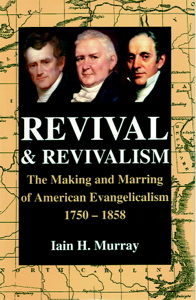 Revival and Revivalism:The Making and Marring of American Evangelicalism by Iain Murray is a book about evangelicalism much more than simply revivals and revivalism. Though not at all what I would consier an objective approach to the subject, Murray aptly handles the period of 1750-1858 with its leaders, revivals, spiritual outpourings and problems.
Revival and Revivalism:The Making and Marring of American Evangelicalism by Iain Murray is a book about evangelicalism much more than simply revivals and revivalism. Though not at all what I would consier an objective approach to the subject, Murray aptly handles the period of 1750-1858 with its leaders, revivals, spiritual outpourings and problems.
Murray is obviously pro-revival, Calvinistic, and Evangelical, but is also anti-revivalism, anti-Arminian, and is decidedly against new measures and emotionalism aimed to bring about a response for the gospel. So long as one goes into this work with that understanding of Murray’s position, I believe the reader will find this book to be one of great worth.
To distinguish, Murray views revival and revivalism as two separate and distinct concepts. For Murray, revival is:
An earnest of future and more plentiful effusions of God’s Spirit; the special and manifest effusions of the Spirit of God; and the blessed effusions of his Holy Spirit in an eminent manner.
Also of revival, Murray writes:
In speaking of the meaning of revival it is also essential to note that what Davies and his brethren believed about Revival was not something separate from, or additional to, their main beliefs; it was, rather, a necessary consequence. Such is man’s state in sin that he cannot be saved without the immediate influence of the Holy Spirit. Regeneration, and the faith that results from it, are the gifts of God. Therefore, wherever conversions are multiplied, the cause is to be found not in men, nor in favourable conditions, but in the abundant influences of the Spirit of God that alone make the testimony of the church effective.
In contrast, Murray views revivalism as works of men intended to rouse the public into a frenzy for the sole purpose of bringing about a public decision. Of old, revival had been seen to be explicitly an activity of a sovereign God, but with revivalism came the belief that revival could be conjured up through the activity of men.
For Finney, an appeal for a public action had become an essential part of evangelism. He believed that all that was needed for conversion was a resolution signified by standing, kneeling, or coming forward, and because the Holy Spirit always acts when a sinner acts, the public resolution could be treated as ‘identical with the miraculous inward change of sudden conversion.’
With this new emphasis on means came new theology that elevated man’s ability, de-emphasized original sin, and in some cases even rejected the historic and orthodox understanding of Christ’s atonement as substitionary.
It was Adam’s will, not his supposed nature, that controlled his actions and, Finney declared, what was true of Adam remained true for all men; a decision, of the will, not a change of nature, was all that was needed for anyone to be converted.
Murray finds great fault with the culture of revivalism that grew up in 19th Century America and that in many ways continues today. He calls for a return to the traditional Calvinism of Puritan and Revolutionary America. Of course, a major problem is that it is the very Revolutionary Spirit of America that brought about such a rejection to God’s sovereignty and the doctrine of God’s election. American’s, who will have no earthly king all too readily reject a heavenly King as well. Following on the heels of this rejection comes a belief in a do-it-yourself capitalistic Christianity. One in which the culture chooses the religion through a free-market, and the market continues to choose a religion that fits their lifestyle…one that is heavily influenced by American participation.
Murry has written a great book, but I am confident that his bias has caused him to over-emphasize the use of means by revivalists at times, but he has done a great job exposing the errors of secular historians recounting the Second Great Awakening by showing that the wild revival meetings, such as the one at Cane Ridge, KY were the exception and not the rule. Murray probably misses some of the good that has come from tent meetings and revival campaigns, but he is possibly prophetic in his call for a return to the orthodox beliefs of yesteryear.
This is a great read for anyone interested in a thorough understanding of evangelicalism and its major players in the years 1750-1858.
